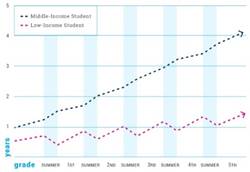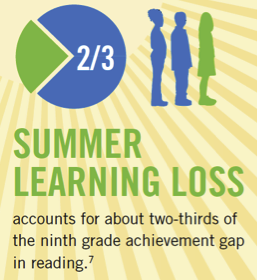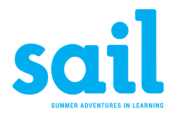Why Summer Matters
Children regress when they don’t practice their academic skills over the summer. This is known as  summer learning loss, or the summer slide. Children from low-income families lose two-three months of grade equivalency in both math and reading every summer, year after year. The loss is cumulative; the gap grows over time.
summer learning loss, or the summer slide. Children from low-income families lose two-three months of grade equivalency in both math and reading every summer, year after year. The loss is cumulative; the gap grows over time.
 A study by Johns Hopkins University measured the gap in reading as three years by the end of the ninth grade. They found that 2/3 of the gap was attributable to summer learning loss. Further, they found that summer learning loss was the primary driver of later problems; failure to graduate, to attend college, and to successfully enter the workforce. To see the Research Brief, click here.
A study by Johns Hopkins University measured the gap in reading as three years by the end of the ninth grade. They found that 2/3 of the gap was attributable to summer learning loss. Further, they found that summer learning loss was the primary driver of later problems; failure to graduate, to attend college, and to successfully enter the workforce. To see the Research Brief, click here.
Children from under-served communities face other challenges over the summer as well; many do not eat well, do not exercise, and lack a safe environment that is free from harmful influences. Parents consistently cite summer as the most difficult time to ensure that their children have productive things to do.
SAIL HAS HELPED OVER 20,000 ALABAMA CHILDREN PREPARE FOR SUCCESSFUL LIVES!
| SAIL programs use research-based curriculum, certified teachers, and Star Assessments® to drive academic growth. | |
| AVERAGE GAIN PER STUDENT | |
| Reading: 1.8 months | Math: 2.6 months |
AVERAGE IMPACT PER STUDENT (Considering the “summer slide” of 2+ months loss for low-income students) | |
| Reading: about 4 months | Math: about 5 months |
| SAIL IS COST EFFECTIVE | SAIL REACHES UNDER-SERVED COMMUNITIES |
| The average cost of a SAIL academic program is around $1,000 per child. When the high academic gains are factored with the reasonable cost, the value of SAIL programs is evident! | In SAIL programs:
|
For a full discussion, visit Outcomes.
